

Tutorial: OSPF Network Types and Frame Relay Part 2. Tutorial: OSPF Network Types and Frame Relay Part 1. Tutorial: Filtering Routes in OSPF Part 2 » Filtering Between Areas Using area filter-list. Tutorial: Filtering Routes in OSPF Part 1 » Filtering Within An Area. Troubleshooting Routing Protocols - BGP/OSPF/EIGRP (2012 Melbourne) Deploying OSPF in a Large-Scale Network (2012 San Diego) Howdy Mr. Neighbor Router: OSPF Adjacency vs. Neighborship. OSPF-Hello (224.0.0.5) to all the network aficionados on the web.
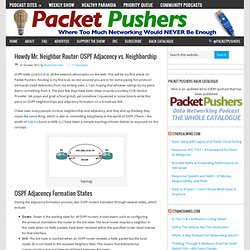
This will be my first article on Packet Pushers. Routing is my first love, so rest assured you are in for some piping hot protocol intricacies (read delicacies) from my writing oven :). I am hoping that whoever swings by my piece learns something from it. The past few days have been sheer insanity (courtesy CCIE-Service Provider lab preps and grad school grind), yet somehow I squeezed in some time to write this piece on OSPF neighborships and adjacency formation on a broadcast link. I have seen many people confuse neighborship and adjacency, and they end up thinking they mean the same thing, which is akin to committing blasphemy in the world of OSPF.
Topology OSPF Adjacency Formation States During the adjacency formation process, two OSPF routers transition through several states, which include: Down. (There. (Note: You can click on the image to enlarge it for better clarity. Nailing the OSPF Adjacency Gotchas References. Conditional OSPF default route origination based on classless IP prefixes - CT3.
From CT3 By Ivan Pepelnjak Recent IOS releases, including IOS release 12.4, 15.0 and 12.2SR, support conditional OSPF default route origination based on route maps using IP prefix lists.
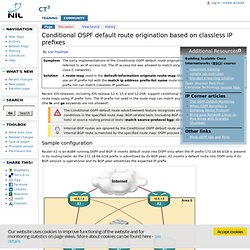
The IP prefix-list used in the route map can match any IP prefix as long as the match is exact (the le and ge keywords are not allowed). The Conditional OSPF default route advertisement feature recognizes only a very small subset of match conditions in the specified route map. Primary/backup area border router designs - CT3. From CT3 By Ivan Pepelnjak Cisco IOS allows you to influence the cost of the default route advertised from an ABR into an OSPF stub area or NSSA area.
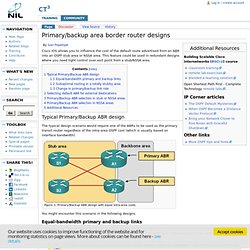
This feature could be used in redundant designs where you need tight control over exit point from a stub/NSSA area. Typical Primary/Backup ABR design The typical design scenario would require one of the ABRs to be used as the primary transit router regardless of the intra-area OSPF cost (which is usually based on interface bandwidth). Figure 1: Primary/Backup ABR design with equal intra-area costs You might encounter this scenario in the following designs: Equal-bandwidth primary and backup links If you have configured the stub area as a totally stubby area (no inter-area summaries are advertised into it), the total intra-area default route cost (the cost of the advertised default route summary + the path cost to the ABR) is the sole route selection criteria.
My Favorite Interview Question. Today’s post is about one of the most basic OSPF rules.

I was often called upon, in past jobs, to conduct technical interviews with applicants to network engineering and professional services positions. A CCIE and experience commensurate with that certification was typically a gateway to just being considered for a technical interview, so these job candidates were no slouches in what they knew. Unless the candidate came from a service provider background they probably had no practical MPLS and IS-IS, and only basic BGP, experience. So I usually couldn’t dig very deep there, and only tried to determine their capacity for quickly coming up to speed on those protocols. I did, however, expect every candidate to have extensive experience with OSPF and that’s where I focused most of my questions.
That leads to my favorite technical interview question, one that I asked almost every time. OSPF Design Guide. Darren's Blog OSPF external prefixes and the Type4 LSA deep dive – part 1 of 2. In my Demystifying the OSPF database post over here, I mentioned the following: This is not 100% correct though.
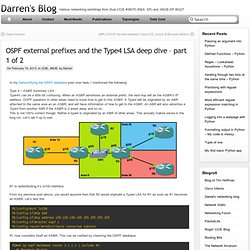
Rather a type4 is originated by an ABR of other areas. This actually makes sense in the long run. Let’s lab it up to see. R1 is redistributing it’s lo100 interface From my previous post above, you would assume then that R2 would originate a Type4 LSA for R1 as soon as R1 becomes an ASBR. Quick Look Into OSPF Database: External and ASBR-Summary LSA.
Sometimes we have the need to inject information from external sources into OSPF routing domain.
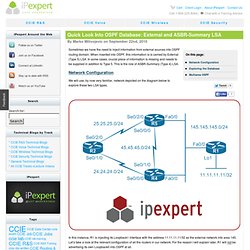
When inserted into OSPF, this information is is carried by External (Type 5) LSA. In some cases, crucial piece of information is missing and needs to be supplied in addition to Type 5. This is the role of ASBR-Summary (Type 4) LSA. Network Configuration We will use, by now very familiar, network depicted on the diagram below to explore these two LSA types. In this instance, R1 is injecting its Loopback1 interface with the address 11.11.11.11/32 as the external network into area 145.
Show 134 – OSPF Design Part 1 – Debunking the Multiple Area Myth.